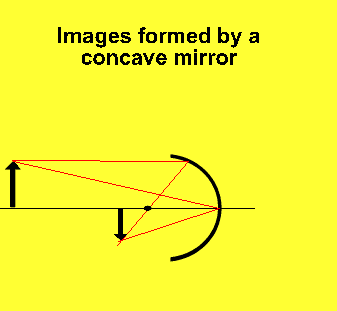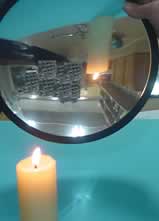Mirrors
The images formed by a distant
object using a concave mirror are real, inverted and reduced in size.
When the object is two focal lengths away the image is at the same distance
from the mirror as the object, real, inverted and the same size as the
object.
Between one and two focal lenghts away the object forms a magnified, real
and inverted image.
As the object gets closer to the mirror (within the focal length) a virtual,
upright and magnified image is formed. Look
at the animation on the right.
Concave mirrors are used to create illusions.
Click to see a 120kb video of the illusion
of the hand shake. Notice how the image of the person's hand appears in
front of the mirror and rises to meet the real hand.


Images formed by a convex mirror are virtual and smaller then the object that formed them. They seem to come from deep inside the mirror.
Look at the animation on the left.
Plane mirrors also produce virtual images.
Image formation with ray diagrams
exercises .
Amazing effects can be created when convex and concave mirrors are combined.
Click to see how.
Look at the image on the right. Describe the image and the type of mirror used.
Is the image virtual or real? Explain.


Look at the image on the left. Describe the image and the type of mirror used.
Is the image virtual or real? Explain.